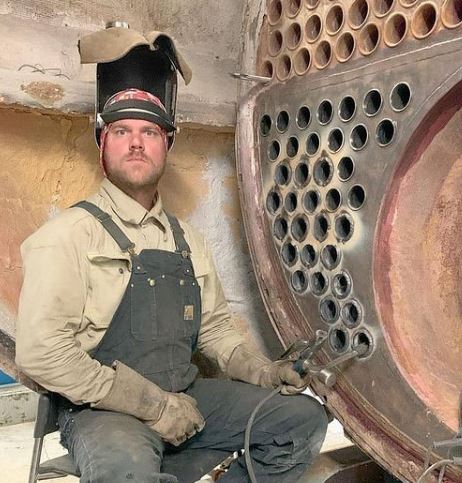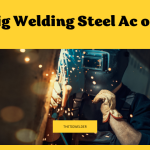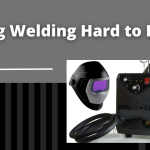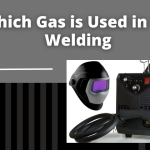TIG (inert tungsten gas) welding and MIG (inert metal gas) welding are two common types of arc welding, which use an electric arc to generate heat to melt and join metal.
TIG welding is a process that uses a tungsten electrode to produce the electric arc and an inert gas (such as argon or helium) to protect the weld from contaminants in the air. It requires a high level of skill and precision to perform, as the welder must manually feed the filler metal into the weld puddle. TIG welding is typically used to create precise, high-quality welds for thin materials.
On the other hand, MIG welding uses a continuously feeding wire as the electrode and shielding gas (such as argon or CO2) to protect the weld. It is a faster and more automated process compared to TIG welding and is often used for welding thicker materials or large-scale production welding. MIG welding is generally easier to learn than TIG welding but may produce less high-quality or precise welds.

TIG Welding
TIG (inert tungsten gas) welding is a type of arc welding that uses a tungsten electrode to produce the electric arc and an inert gas (such as argon or helium) to protect the weld from contaminants in the air. As the arc is maintained, the welder manually feeds the filler metal into the weld puddle.
To perform TIG welding, the welder must first clean the metal surfaces to be welded and attach the workpieces to a welding table or jig. The welder then sets up the TIG welding machine, which includes connecting the tungsten electrode to the power source, setting the desired welding current, and attaching the gas cylinder and flow meter.
Next, the welder puts on protective gear, including a welding helmet, gloves, and a fire-resistant jacket. The welder then strikes an arc by touching the tungsten electrode to the metal surfaces and pulling it away slightly. The welder moves the electrode along the joint, maintaining a consistent distance from the workpiece and feeding the filler metal into the weld puddle as needed.
TIG welding requires a high level of skill and precision, as the welder must constantly adjust the welding current, filler metal feed rate, and arc length to maintain the desired weld quality. It is often used for thin materials and for creating precise, high-quality welds.
MIG Welding
MIG (inert metal gas) welding is a type of arc welding that uses a continuously feeding wire as the electrode and shielding gas (such as argon or CO2) to protect the weld. It is a faster and more automated process compared to TIG welding and is often used for welding thicker materials or large-scale production welding.
To perform MIG welding, the welder first sets up the MIG welding machine, which includes attaching the wire spool, setting the desired welding current, and attaching the gas cylinder and flow meter. The welder then puts on protective gear, including a welding helmet, gloves, and a fire-resistant jacket.
Next, the welder cleans the metal surfaces to be welded and attaches the workpieces to a welding table or jig. The welder then strikes an arc by touching the wire to the metal surfaces and pulling it away slightly. The welder moves the gun along the joint, maintaining a consistent distance from the workpiece and allowing the wire to feed continuously.
MIG welding is generally easier to learn than TIG welding, as it is more automated. However, it may not produce as high-quality or precise welds as TIG welding, as the weld puddle is not as easy to control.
Comparison of TIG and MIG Welding
Several key differences between TIG and MIG welding may influence the type of welding best suited for a particular application.
Temperature: TIG welding typically operates at a lower temperature than MIG welding. This can be an advantage when welding thin or heat-sensitive materials, as it helps to prevent distortion or warping. However, it can also make TIG welding slower and more time-consuming, as the lower temperature means the welder must spend more time in the welding position.
Speed: MIG welding is generally faster than TIG welding, as the continuous wire feed allows the welder to quickly cover a larger area. This can be a major advantage for large-scale production welding, where speed is a major factor. However, MIG welding may produce wider and less precise welds than TIG welding, as the weld puddle is harder to control.
Versatility: TIG welding is generally more versatile than MIG welding, as it can be used on a wider range of materials and thicknesses. TIG welding can be used on thin materials such as aluminum, stainless steel, and copper, as well as on thicker materials such as mild steel and cast iron. MIG welding is generally best suited for thicker materials, such as mild and stainless steel.
Cost: MIG welding is generally less expensive than TIG welding, as the equipment and consumables are generally less expensive. However, TIG welding may be more cost-effective in the long run, as it can produce higher-quality welds requiring fewer repairs or rework.
Conclusion
In conclusion, TIG and MIG welding are useful techniques for joining metal. Still, they have several key differences that may make one more suitable than the other for a specific application.
TIG welding is a precise and high-quality process that operates at a lower temperature and is suitable for a wide range of materials and thicknesses. However, it is slower and more time-consuming than MIG welding and may require a higher skill level.
MIG welding is a faster and more automated process well-suited for large-scale production welding and thicker materials. However, it may produce wider and less precise welds than TIG welding and may only be suitable for some materials and thicknesses.
When deciding which type of welding to use, it is important to consider factors such as the material and thickness of the workpiece, the desired weld quality, and the available equipment and resources. TIG and MIG welding can be valuable tools for metal fabrication and repair, but the specific application will determine the most appropriate choice.

It’s been years since I got into welding as a side hustle. It’s been so long since Doing All kinds of welds for business and pleasure as this is my hobby. Being in this field I have learned from hands-on-experience also came to know what gears work and what doesn’t. The Tig Welder is my own platform where I use to share my experience.






Leave a Reply